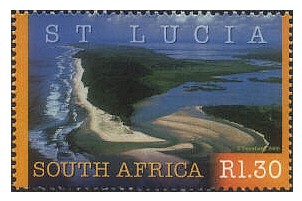


iSsimangaliso Wetland Park consists of thirteen contiguous protected areas with a total size of 234,566 hectares. The site is the largest estuarine system in Africa and includes the southernmost extension of coral reefs on the continent.
Mandela was imprisoned here.

The Taung Skull Fossil Site, part of the extension, is the place where in 1924 the celebrated Taung Skull - a specimen of the species Australopithecus africanus - was found. Makapan Valley, also in the site, features in its many archaeological caves traces of human occupation and evolution dating back some 3.3 million years.
One thousand years ago, Mapungubwe in Limpopo province was the center of the largest kingdom in the African sub-continent, where a highly sophisticated people traded gold and ivory with China, India and Egypt.
Eight areas are included in this listing:
The world's oldest and largest visible meteor impact crater.
This vast desert area has been associated with the former San hunter-gatherers since the stone age. It is located amongst the sand dunes of the Kalahari Gemsbok National Park.
The Barberton Makhonjwa Mountains represents the best-preserved succession of volcanic and sedimentary rock dating back 3.6 to 3.25 billion years, when the first continents were starting to form on the primitive Earth. It features meteor-impact fallback breccias resulting from the impact of meteorites formed just after the Great Bombardment (4.6 to 3.8 billion years ago).
Serial property includes 3 dispersed archaeological sites: Diepkloof Rock Shelter, Pinnacle Point Site Complex, and Sibhudu Cave. These sites provide the best-preserved record known of the development of modern human behaviour, reaching back as far as 162,000 years.
This property consists of fourteen component parts located around the country, all related to South Africa’s political history in the 20th century. They include the Union Buildings of Pretoria, now the official seat of government; the Sharpeville Sites, commemorating the massacre of 69 people protesting the unjust Pass Laws; and The Great Place at Mqhekezweni, a site symbolic of traditional leadership where Nelson Mandela lived as a young man.
Last updated: July 27, 2023